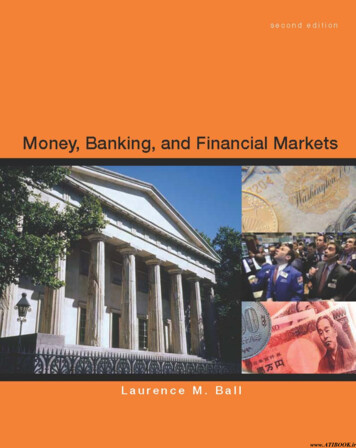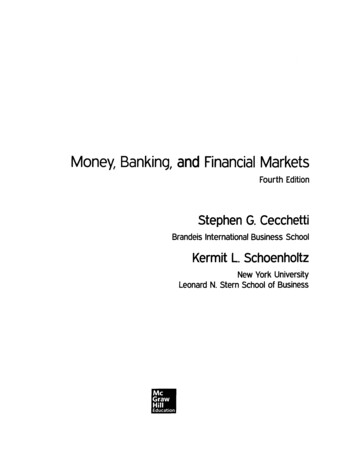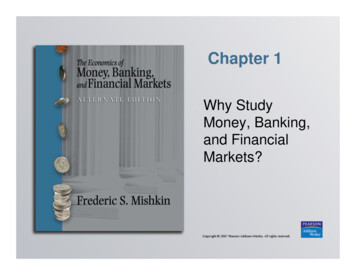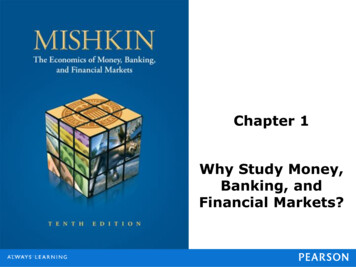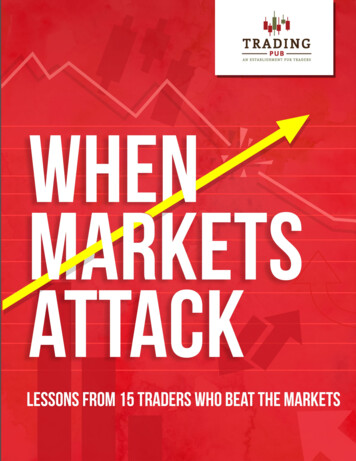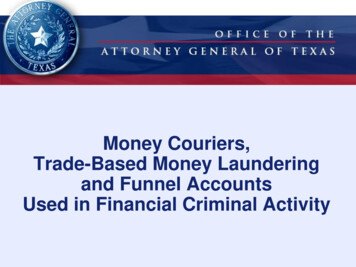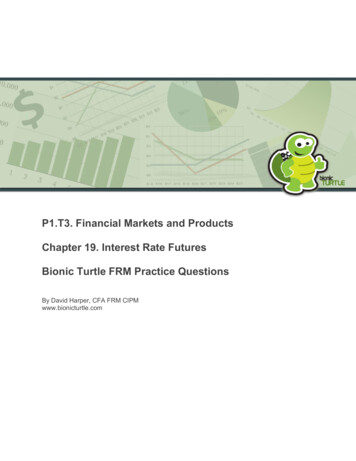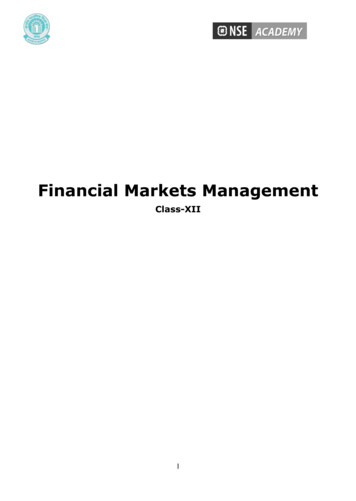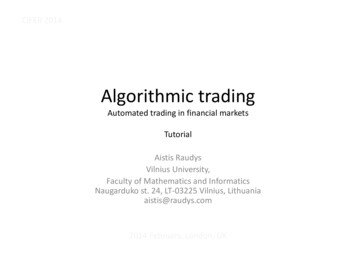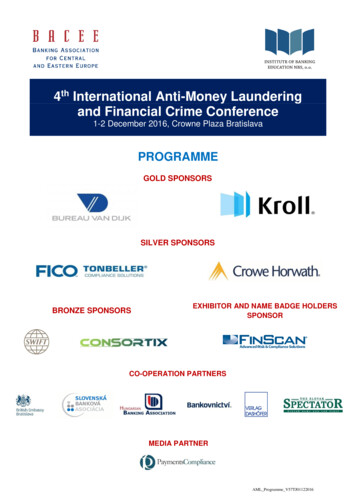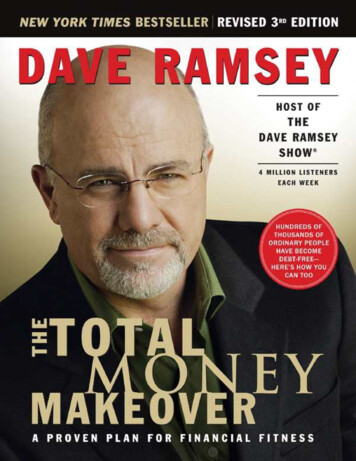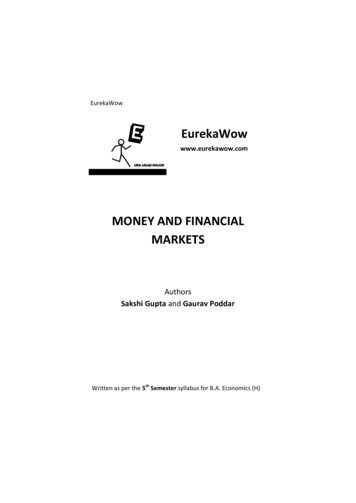
Transcription
EurekaWowEurekaWowwww.eurekawow.comMONEY AND FINANCIALMARKETSAuthorsSakshi Gupta and Gaurav PoddarWritten as per the 5th Semester syllabus for B.A. Economics (H)
EurekaWow EurekaWowFirst Edition – September 2013EurekaWowwww.eurekawow.comE-mail: eureka123.ssc@gmail.comFollow us on facebook: www.facebook.com/Eurekawow
EurekaWowACKNOWLEDGEMENTSEurekaWow thanks our publishers for encouraging ourentrepreneurial venture. We sincerely thank our new memberswho have joined us and helped us in our venture. We would alsolike to thank our alma mater, St. Stephen’s College, whichprovided us a perfect platform for initiating our project.
EurekaWowDedicated to our enthusiastic readerswho keep us on our toes
EurekaWowPREFACEDear ReaderHumbled by the success of our first three ‘Wow-Books’,EurekaWow brings to you the fruit of its latest toils – a help bookfor Money and Financial Markets. It has taken us a considerableamount of time and effort to compile this book and we hope thatyou find it helpful.Money and Financial Markets is a vast course which requires alot of reading and understanding of financial terms and relatedconcepts. Sometimes, it becomes difficult to link various readingsand understand the complex financial terms.So, here we have aimed to keep the readings summarized, withthe main bullets presented in a manner that can help youunderstand and organize your thoughts and present them intoanswers as per the question asked. We understand themonotony of those spiral readings that never end and thus thisbook summarizes the syllabus without compromising on thequality of the material.How to Study?1. Get yourself very familiar with the facts about thefinancial sector. Visit RBI website regularly.2. An ideal answer in the exam gives analysis instead offacts. Even a parrot can produce a flawless fact-sheet ofreforms undertaken or say definition of financial terms.What you are required to furnish is a spatial or temporalanalysis of the issue concerned. Try practicing writing a
EurekaWowfully fledged answer from the past year questions givenat the end of every topic. Also practice numericalquestions.If you want feedback on your mock answers, mail them to us ateureka123.ssc@gmail.com. We will be ever ready to give a peerreview - constructive criticism and tips for improvement! Also,we are starting a forum on our website www.eurekawow.comwhere you can post your queries and answer questions byothers. We recommend you to participate in those discussions.As you begin another journey through the pages of this Moneyand Financial Markets Wow-book, we wish you good luck foryour final exams.Btw, if you find any errors or printing mistakes, do shoot us amail, we will love to improve our content quality and keepdelivering our best.Sincerely,EurekaWow
EurekaWowCONTENTSTopicsTopic 1Money, Concept and Functions, Measurements,Theories of Money Supply DeterminantsTopic 2Financial Institutions, Markets, Instruments andFinancial InnovationsTopic 3Interest Rates, determination, sources of interestrate differentials, theories of term structure ofinterest rates; interest rates in IndiaTopic 4Banking system, Changing role and structure,Banking Sector ReformsTopic 5Central banking and Monetary Policy – Functions,Balance Sheet, Goals, Targets, Indicators,Instruments of Monetary Control, MonetaryManagement in an Open Economy, CurrentMonetary Policy of IndiaPageNumber946111148163
EurekaWow
EurekaWowTOPIC – 1Chapter1.1 – Money1.2 – Measurementof Money1.3 – Money SupplyProcessReferencesBaye and Jansen – Chapter1Jadhav – Chapter 2RBI ReportJadhav – Chapter 2Baye and Jansen – Chapter14PageNumber91926CHAPTER – 1.1MONEYMoney is anything generally accepted by the society as amedium of exchange, i.e. anything used to pay for goods andservices or settles debts. Coins and rupee notes (currency) whichare widely accepted by the society as means to settletransactions thus form a part of money supply. Traveler’s checks,checks against current accounts are other commonly used formsof money.Liquidity describes how easily and cheaply an asset can beconverted into medium of exchange. On one hand we havesavings account which can easily and quickly be converted intomedium of exchange and thus is liquid asset. On the other handis real estate, an illiquid asset, as it is difficult to convert it intomedium of exchange.9 Money and Financial Markets
EurekaWowFUNCTIONS1. Medium of exchange:The use of money in an economy as a medium ofexchange is its primary function. Goods, services,financial assets etc. are all paid for by using money.Barter, where goods and services are exchanged forother goods and services without the intermediation ofmoney is another way of making transactions. However,there exist two problems with iti) Double coincidence of wants- Each party involved inthe transaction must have something the otherdesires, even if one party doesn’t want the goodother is trading, transaction won’t happen.ii) Transaction costs- Barter is highly inefficient becauseparties involved will have to spend considerable timesearching for others who are willing to accept thegood one is trying to sell as payment for somethingthat he wants to have. This search time forms a partof transaction cost (cost borne in making exchange).Monetary economies i.e. the economies that use moneyas a medium of exchange are capable of solving both theabove problems because now a person can simplyexchange the good he produces for money and then usethis to buy what he wants instead of trying to find doublecoincidence of wants.2. Unit of account:The value of all goods and services can be stated in termsof money. Generally since the medium of exchange is10 Money and Financial Markets
EurekaWowvirtually common to all transactions thus it is convenientto state all prices in terms of it. The use of moneyreduces the amount of information that individuals needto operate in the market. In the absence of a commonunit of account there would be more prices than goods inthe economy. (If there are n goods, then there will ben*(n-1)/2 prices). The presence of money as a unit ofaccount reduces the price information needed and thusreduces transactions cost associated with exchange.3. Store of value:Money is a means of storing today’s purchasing power topurchase tomorrow. In the absence of money (or otherassets) goods will have to be stored to trade in future,even those goods which they personally didn’t wish toconsume but thought that others would demand forsomething they wished to purchase. Storage ofcommodities has two issues- (a) perishability i.e. somegoods (like fruits, milk) will be of no/little value in future;(b) high cost of maintenance for non-perishable goodslike cars. Both these problems are eliminated by the useof money. Money has its upper hand as a temporarystore of value because of its liquidity property, it can beused anytime in the future to make transactions, butthere exist other better store of values (over longerperiods) like savings accounts, stocks etc. which even payinterests and dividends.4. Standard for deferred payment:Money is used to state payments that are deferred to thefuture. In the absence of money, future payments wouldhave to be made in terms of other goods. Having a11 Money and Financial Markets
EurekaWowcommon standard for deferred payments as medium ofexchange and unit of account makes it easier todetermine exactly how much a deferred payment will be.Money however is not the best standard for all purposes.ORIGINS OF MONEYReligious objects of value used as medium of exchange Barter System Monetary Economy (use of gold asmedium of exchange) Paper CurrencyTypes of Money:1. Commodity Money: Any physical commodity that is usedas money but at the same time has alternative nonmonetary uses is called commodity money e.g. gold andsilver coins (they are also used in jewelry so haveindependent value). Commodity money can be of twotypes(a) Full-bodied money- When commodity itselfcirculates as money then it is known as full bodiedmoney. Monetary value non-monetary value of fullbodied money.(b) Representative full bodied money- When papermoney that represents a claim to a specific quantityof some commodity circulates as money then it isknown as representative full bodied money e.g. goldcertificates. Here the non-monetary value of theactual item exchanged is negligible but is moreconveniently used as money.12 Money and Financial Markets
EurekaWow2. Fiat Money: Anything that is money by legal tender andis unbacked by any commodity like unbacked papermoney or token coins is called fiat money. It has no valueas a commodity and doesn’t represent a claim to anyphysical commodity. It is backed only by its generalacceptance by society as a medium of exchange.Physical Properties of Money1. Portability- Money should be portable to maketransactions easier. The easier it is to carry around, themore effective it is as a medium of exchange. Moneyshould generally be a substance that is valuable in smallquantities.2. Divisibility- To be able to do transactions of various sizes,money should be made of a commodity that is divisibleinto smaller units. Gold and silver can be minted in theform of small coins thus facilitate small transactions.3. Durability- Money should not wear out in use and shouldnot depreciate quickly when not in use i.e. it should bedurable.4. Recognizable Value- It should be easy for people engagedin exchange to agree to the value of good used as money,it should have value recognized by all. The moderncurrency has complicated engraving, rare papers and ink toavoid counterfeiting of fiat currency.The Evolution of BanksBanks are financial institutions that accept deposits and makeloans.13 Money and Financial Markets
EurekaWowDuring the middle ages, gold and silver (specie) were used as fullbodied medium of exchange. To save the specie from theft, fireetc. goldsmiths offered accommodations for this specie in theirstrongboxes.Initially the goldsmiths only provided safekeeping for speciedeposits and charged depositors a fee for the service. Graduallyit was realized that it wasn’t necessary for depositors to go to thegoldsmith every time one needed to make some transaction,they could rather use a written order to pay for goods andservices. The written order would state that the depositor wasauthorizing the goldsmith to pay specified amount to the personnamed on the order. This reduced transaction costs. The personwho received the payment had two options either withdraw thegold and put in his own account or use the written order to payto someone else. But the same written order could be used onlyif the value of purchase was the same, this limited the number oftimes this “check” would change hands.Another innovation in this regard was the bank note- a documentwritten by earlier goldsmiths promising to pay sum specie to thebearer on demand. These were issued in convenientdenominations to foster transactions. These bank notes were likemodern day checks and currency the basic difference being thatthese were issued by banks (goldsmiths) rather thangovernment. Bank notes have one advantage over checks i.e.they are issued in convenient denominations and are easily usedin second transactions which allows them to circulate for longer.However one disadvantage is that they are more prone to theftas the bank notes pay the bearer on demand.14 Money and Financial Markets
EurekaWowA typical T-account of a bank issuing bank notes looks like thefollowing:AssetsReserves (gold in vault) 100LiabilitiesBank Notes 25Demand Deposits 75Fractional Reserve BankingInitially the goldsmiths only acted as depositories maintaining100% reserves (reserves total value of outstanding bank notesand demand deposits) and earning in the form of service fee.However they realized that most of the specie in their vaults wasnever withdrawn, it sat idle and bank notes and demand depositscirculated as money. So they adopted the fractional reservebanking method where they maintained only a fraction of thebank notes and demand deposits as reserves and gave out therest as loans and earned extra profits in terms of the interest onloans. They issued more bank notes than was there gold in thevaults.The balance sheet now looked like the following:AssetsLiabilitiesReserves (gold in vault)Bank Notes 20 25LoansDemand Deposits 80 7515 Money and Financial Markets
EurekaWowThe money supply in the absence of banks was 100 of goldwhich stayed 100 in 100% reserve banking system but was inthe form of bank notes and demand deposits. In case offractional reserve system an additional 80 in the form of goldwas created by the bank when it gave out loans. Now totalmoney supply became 180. This gold is again kept with thegoldsmiths/banks which keep a part of it (say 20%) and lend outthe rest.AssetsLiabilitiesReserves (gold in vault)Bank Notes 20 80 25LoansDemand Deposits 80 75 80 155The bank now keeps lends out 80% of 80 64 and keep therest as reserves. The process continues until the bank is fullyloaned out.AssetsLiabilitiesReserves (gold in vault)Bank Notes 100 25LoansDemand Deposits 400 475The bank still has 100 of gold in its reserves, but with 20%reserve requirement it has been able to create money supplyequal to 500. This means that incase all the depositors claimredemption on the same day, the bank wouldn’t be able to honorthem and would be illiquid i.e. it doesn’t have enough liquidassets to honor its obligations. A bank is said to be bankruptwhen the value of its liabilities exceeds its assets. Therefore a16 Money and Financial Markets
EurekaWowbank can be illiquid but not bankrupt and can be bankruptwithout being illiquid. When a bank faces a long line ofdepositors and note holders demanding redemption, it is called arun on the bank. This has a potential threat even to healthybanks because under fractional reserve banking no bank canactually honor all its obligations if all are redeemed a
Money and Financial Markets is a vast course which requires a lot of reading and understanding of financial terms and related concepts. Sometimes, it becomes difficult to link various readings and understand the complex financial terms. So, here we have aimed to keep the readings summarized, with the main bullets presented in a manner that can help you understand and organize your thoughts and .

